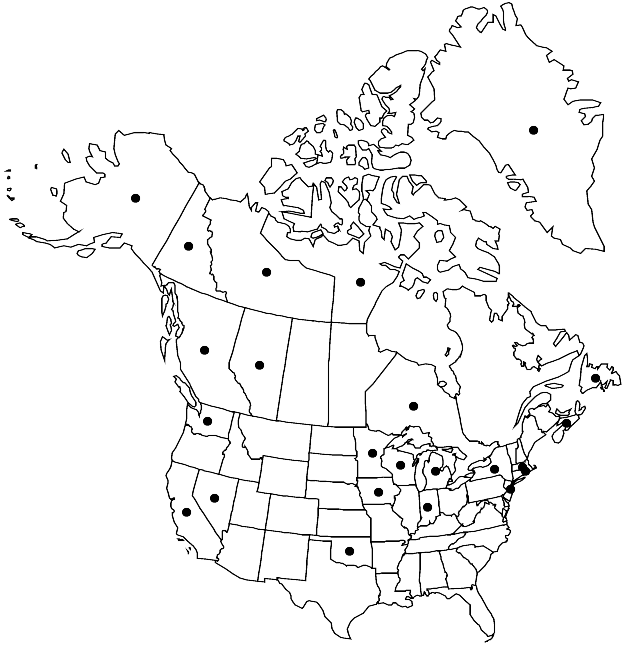Difference between revisions of "Drepanocladus sordidus"
Mem. New York Bot. Gard. 82: 217. 1998.
FNA>Volume Importer |
FNA>Volume Importer |
||
| Line 18: | Line 18: | ||
|name=Cratoneuron sordidum | |name=Cratoneuron sordidum | ||
|authority=(Müller Hal.) Brotherus | |authority=(Müller Hal.) Brotherus | ||
| − | }}{{Treatment/ID/Synonym | + | }} {{Treatment/ID/Synonym |
|name=Drepanocladus exannulatus var. mexicanus | |name=Drepanocladus exannulatus var. mexicanus | ||
|authority=Cardot | |authority=Cardot | ||
| − | }}{{Treatment/ID/Synonym | + | }} {{Treatment/ID/Synonym |
|name=D. tenuinervis | |name=D. tenuinervis | ||
|authority=unknown | |authority=unknown | ||
| Line 38: | Line 38: | ||
|elevation=low to high elevations | |elevation=low to high elevations | ||
|distribution=Greenland;Alta.;B.C.;Nfld. and Labr. (Nfld.);N.W.T.;N.S.;Nunavut;Ont.;Yukon;Alaska;Calif.;Ind.;Iowa;Mass.;Mich.;Minn.;Nev.;N.J.;N.Y.;Okla.;R.I.;Wash.;Wis.;Mexico;Central America;South America;Eurasia. | |distribution=Greenland;Alta.;B.C.;Nfld. and Labr. (Nfld.);N.W.T.;N.S.;Nunavut;Ont.;Yukon;Alaska;Calif.;Ind.;Iowa;Mass.;Mich.;Minn.;Nev.;N.J.;N.Y.;Okla.;R.I.;Wash.;Wis.;Mexico;Central America;South America;Eurasia. | ||
| − | |discussion=<p>Drepanocladus sordidus and 7. D. latinervis are recognized by their almost always strongly falcate leaves, relatively small alar groups, and relatively strong, non-excurrent costae; for differences between the two species, see the discussion of the latter.</p> | + | |discussion=<p><i>Drepanocladus sordidus</i> and 7. <i>D. latinervis</i> are recognized by their almost always strongly falcate leaves, relatively small alar groups, and relatively strong, non-excurrent costae; for differences between the two species, see the discussion of the latter.</p> |
|tables= | |tables= | ||
|references= | |references= | ||
| Line 61: | Line 61: | ||
|publication year=1998 | |publication year=1998 | ||
|special status=Selected by author to be illustrated | |special status=Selected by author to be illustrated | ||
| − | |source xml=https://jpend@bitbucket.org/aafc-mbb/fna-data-curation.git/src/ | + | |source xml=https://jpend@bitbucket.org/aafc-mbb/fna-data-curation.git/src/8f726806613d60c220dc4493de13607dd3150896/coarse_grained_fna_xml/V28/V28_462.xml |
|genus=Drepanocladus | |genus=Drepanocladus | ||
|species=Drepanocladus sordidus | |species=Drepanocladus sordidus | ||
Revision as of 17:05, 18 September 2019
Plants medium-sized, sometimes small or large. Stems pinnate or irregularly pinnate. Stem leaves strongly falcate-secund, rarely weakly so, ovate, broadly ovate, or triangular-ovate, gradually narrowed to apex, ± strongly concave, 1.4–5.2 × 0.4–1.4 mm; base erect or erectopatent, insertion slightly curved; margins entire or weakly and obtusely denticulate; apex acuminate, acumen gradually differentiated, mostly furrowed; costa single, ending beyond mid leaf, mostly in acumen but not excurrent; alar region quadrate or transversely short-triangular, reaching from margin 40–60% distance to costa; ratio of medial laminal cell length (µm) to leaf length (mm) 23.3–36.5. Sexual condition dioicous.
Habitat: Intermediately mineral-rich, meso- to eutrophic habitats, submerged in lakes, pools, ox-bow lakes, terrestrial wetland habitats, fens
Elevation: low to high elevations
Distribution

Greenland, Alta., B.C., Nfld. and Labr. (Nfld.), N.W.T., N.S., Nunavut, Ont., Yukon, Alaska, Calif., Ind., Iowa, Mass., Mich., Minn., Nev., N.J., N.Y., Okla., R.I., Wash., Wis., Mexico, Central America, South America, Eurasia.
Discussion
Drepanocladus sordidus and 7. D. latinervis are recognized by their almost always strongly falcate leaves, relatively small alar groups, and relatively strong, non-excurrent costae; for differences between the two species, see the discussion of the latter.
Selected References
None.
